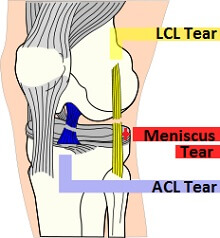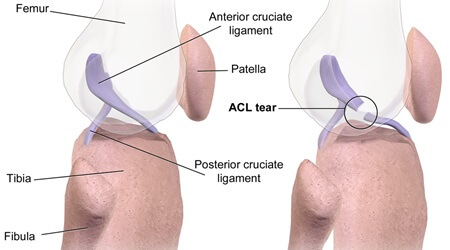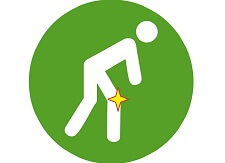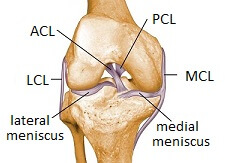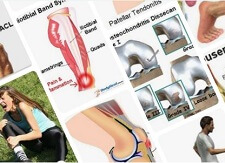- Home
- Common Knee Injuries
- ACL Injury
ACL Knee Injury
Written By: Chloe Wilson, BSc(Hons) Physiotherapy
Reviewed by: KPE Medical Review Board
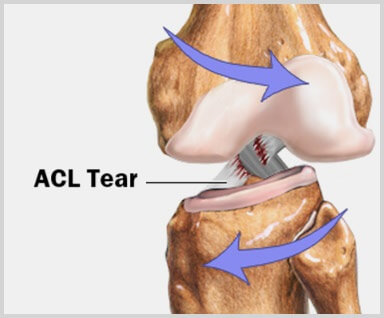
An ACL knee injury is a common problem in sport but did you know that only 20% of all ACL injuries are a result of direct contact?
The majority of ACL injuries occur from awkward twisting movements of the knee, particularly when the foot is stuck to the ground.
Injuries range from a minor sprain to a complete rupture and depending on the severity can take months to fully recover from. It may be a simple set of rehab exercises or full blown knee surgery.
Here we will look at answers to the most common questions about an ACL knee injury including how it happens, ACL symptoms after injury, accurate diagnosis, associated injuries, treatment options and prevention strategies as well as looking more in-depth about why the role of the ACL is so important.
What Is The ACL?
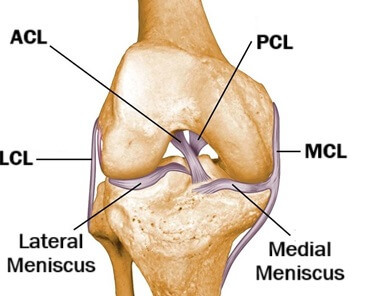
The anterior cruciate ligament (ACL) is one of four ligaments in the knee which sits deep inside the middle of the joint.
"Anterior" means situated at the front, "cruciate" means shaped like a cross and a "ligament" is a band of tissue connecting bones.
It is an extremely important knee ligament as it controls the stability of the knee, preventing the lower leg from sliding too far forwards or twisting too much. The ACL is 2cm long, as thick as a pencil and extremely strong. LEARN MORE >
What is an ACL Tear?
An ACL knee injury occurs when the anterior cruciate ligament is overstretched, usually by the knee bending backwards too far or twisting awkwardly. These can result in:
- Partial ACL Tear: where only some of the ligament fibres are torn or
- ACL Rupture: where the ligament tears completely
The ACL can be stretched just under 2mm before it will tear. In some cases, nearby structures such as the knee meniscus and medial collateral ligament may also be damaged at the same time.
What Causes an ACL Knee Injury?
An ACL knee injury can occur either when there is direct contact with the knee or from an awkward movement, usually when the foot is fixed to the ground e.g. when wearing studs/cleats.
Non-Contact ACL Injuries
Non-contact injuries account for 80% of all anterior cruciate ligament injuries and are caused by:
- Twisting the Knee: very quickly e.g. pivoting, changing direction
- Landing Awkwardly: from a jump
- Hyper-Extending the Knee: when the knee bends the wrong way by more than 10° causing it to gap at the back
- Sudden Deceleration: coming to an abrupt stop whilst the foot is firmly planted
Contact ACL Injuries
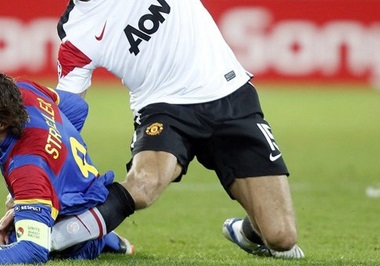
Contact injuries account for only 20% of all ACL knee injuries.
In most cases they are caused by a blow to the side of the knee when the foot is firmly planted to the ground e.g. with studs, which forces the shin bone too far inwards or backwards
An ACL knee injury can also occur at other times, for example car accidents, falling from a height, or from wear and tear.
Gender Effect
Whilst ACL knee injuries most commonly occur in men, this is because they are more likely to play high risk sports. In actual fact, studies have shown that women are at greater risk being approximately 5 times more likely to suffer from an ACL knee injury than men.
This is thought to be due to a combination of factors including hormone levels, ligament structure, pelvis angle, hamstring flexibility and size of the ligament itself.
ACL Symptoms after Injury
The most common ACL symptoms experienced with an injury are:
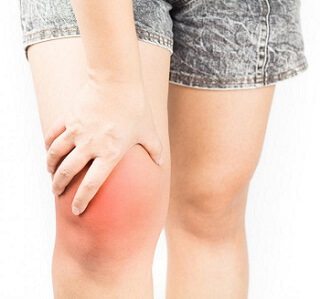
- Audible Noise: approximately 50% of the time there is a popping/cracking noise at the time of injury with ACL ruptures.
- Swelling:there is usually immediate swelling with a completely ruptured ACL injury, certainly within 6 hours, which is often extensive. If however it's only a small tear the swelling may develop a few days later and may be fairly minor. Swelling occurs due to damage to the blood vessels inside the knee - haemarthrosis.
- Pain: there is usually immediate pain after an ACL knee injury especially when you put any weight on the leg or try and bend the knee.
- Giving Way: the knee often feels unstable and may buckle and give way with ACL knee injuries. If the ACL has completely ruptured, this instability will often be an ongoing problem.
- Restricted Movement:knee movement is often limited after an ACL knee injury, particularly knee extension.
Diagnosing an ACL Injury
A doctor can usually accurately diagnose an ACL knee injury by carrying out a clinical examination. The most common tests used are the Pivot Shift, Anterior Drawer and Lachmans Tests.
Diagnosis of ACL tears is often confirmed with an MRI which will also show if any other structures in the knee have been damaged as well.
Associated Injuries
Sometimes with an ACL knee injury, the force going through the knee is so great that other nearby structures are damaged at the same time.
The most common associated injury is a meniscus tear, the special cartilage which lines the knee joint. A tear of the lateral meniscus on the outer side of the knee is most common with an ACL knee injury.
Sometimes the medial collateral ligament is also damaged. When all three structures are injured, it is known as the Unhappy Triad / O'Donoghue Triad. This most commonly happens when injury comes from a force through the outer side of the knee when the foot is fixed on the ground.
ACL Treatment Options
Treatment of an ACL knee injury will depend on a combination of things:
- degree of injury
- level of instability
- lifestyle of the individual
ACL injuries can be managed either surgically or conservatively with an exercise programme.
Immediately after an ACL knee injury, the best thing to do is follow PRICE principles - protect, rest, ice, compression and elevation. After this, there are two treatment options:
1. Exercise Rehab Programme
Exercise programmes for a partially or completely torn ACL look to build up the strength of the knee muscles so that they provide enough support and stability for the knee to compensate for the torn ACL. They also help train the muscles and other ligaments to provide proprioceptive feedback to gain more stability.
It usually takes a few months of rehab to fully recover conservatively from an ACL knee injury. For someone who does not intend to return to sport, or only do
activities such as cycling and running, rehab is usually the preferred treatment. LEARN MORE >
2. ACL Knee Surgery
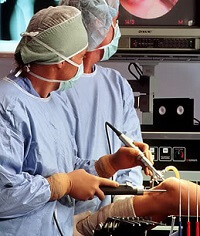
ACL surgery is indicated if the knee keeps giving way/buckling. Any time this happens, there is a risk of damage to the other structures in the knee, particularly the cartilage/meniscus.
It is important to avoid repeated giving way of the knee as if the meniscus tears, there is less protection for the knee bones and increases the risk of developing arthritis. Surgery is therefore indicated in individuals who
- Want to return to pivoting type sports e.g. football, skiing, tennis, rugby, boxing, hockey
- Have problems with the knee giving way during their everyday activities
There are two surgical options depending on the type of ACL knee injury. In some cases, the ligament can be repaired, but more commonly, it needs to be replaced with a new substitute ligament, known as an ACL reconstruction.
If other structures have also been damaged, such as the meniscus, they are also sorted out at the same time. LEARN MORE >
3. Knee Braces
Something else that can really help after an ACL knee injury, whether you need knee surgery or not, is an ACL knee brace to provide extra stability.
Many people find they are able to continue with sports after a partial or full tear of their anterior cruciate ligament if they find the right brace. There are a whole range of ACL knee braces on offer that provide different levels of support and restriction. LEARN MORE >
Why Is the ACL So Important?
As well as protecting against abnormal knee movements, the anterior cruciate ligament is also the primary structure for providing proprioception in the knee.
Proprioception is where the nerve fibres give the body a sense of the knees position and movement – a normal feature for all joints.
For example, close your eyes and touch your finger to your nose. You can do it accurately even though you can’t see what you are doing – proprioception lets you know where the different parts of your body are and what they are doing.
The anterior cruciate ligament is responsible for providing proprioceptive input at the knee, sending important information to the muscles that provide the reflex control of knee movement – meaning they constantly make small adjustments to the knee to keep it stable without us being consciously aware of it.
Without the anterior cruciate ligament, the knee loses it proprioceptive input and therefore is unable to help the muscles make subtle adjustments to keep the knee stable e.g. when changing direction or when on uneven ground.
With an ACL knee injury, this loss of proprioception can be compensated for, to a certain extent, by specific exercises for the knee muscles. However, for people who have a high demand for proprioception e.g. those who play sports, this may not be enough.
Preventing ACL Injuries
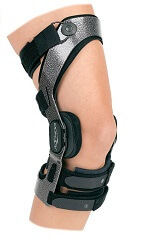
Prevention is always better than cure and this is particularly the case with an ACL knee injury due to the long recovery time, cost and potential problems in the future.
There are a number of things you can do to reduce the risk of anterior cruciate ligament injury including special exercise programmes and wearing a specially designed knee brace.
You
can find out lots more in the ACL knee injury prevention section.
Related Topics
Everything you need to know about ACL knee injuries:
- ACL Injury Overview: Causes, symptoms and diagnosis
- ACL Surgery: Do you need surgery and what does it involve
- ACL Reconstruction: What happens before, during and after surgery
- ACL Surgery Problems: Potential problems encountered after surgery
- Recovering From Surgery: Recovery time guide following surgery
- ACL Rehab Protocol: Rehab exercises & activities after surgery
- Injury Prevention: How to avoid an ACL knee injury
Related Articles
Last Updated: November 4th, 2025
Next Review Due: November 4th, 2027
